Knight’s Armament Company SR-25 Enhanced Match Rifle. This rifle is based on the battle proven Mk11 Mod 0 with the updated KAC URX rail system.
By Christopher R. Bartocci
In the late 1950s a new rifle was developed that would change the entire concept of the battle rifle. Although the U.S. Ordnance Corps had no vision to see it, history was in the making. Eugene M. Stoner while working for ArmaLite, a division of the Fairchild Engine and Aircraft of Hollywood, California, developed the AR-10. Taking his experience in the aircraft industry he replaced traditional wood stocks with new synthetic materials and changed from a traditional steel receiver to lightweight aircraft aluminum considerably decreasing the weight of the weapon. Another innovation was the use of a direct gas system instead of the traditional piston operating system. His design was very radical for that time. With the M14 nearly already adopted, the 7.62x51mm AR-10 was submitted to compete. As expected, the M14 was adopted but the AR-10 was noticed for being abnormally accurate for an auto-loading rifle. From there the AR-10 was cast into the bottomless scrap heap of the not invented here weapons of the U.S. Ordnance Corps. Although a request from the Air Force would have the AR-10 scaled down to .22 caliber and the birth of the AR-15 would go on to revolutionize the battle rifle and have a more then 50 year legacy of the longest serving U.S. rifle in history, the AR-10 lay dormant. That was until Gene Stoner teamed up with C. Reed Knight Jr. of Knight’s Armament Company (KAC) and went back to work on his AR-10 that he never had quite given up on. However, there had been several improvements to the M16 series and he would carry many of them over to his updated AR-10 and developed the SR-25. The acronym stood for Stoner Rifle and added the 10 from the AR-10 with the 15 from AR-15.
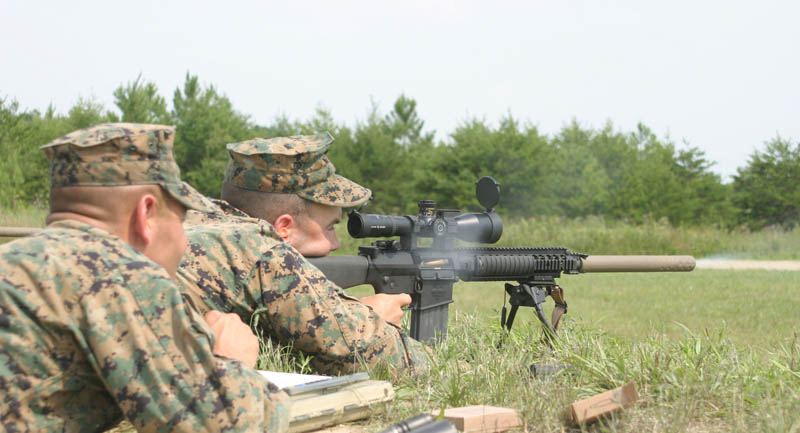
Introduced in the early 1990s the SR-25 shared 60% parts compatibility with the current issue M16A2. Funding for the SR-25 development came through commercial sales. As first introduced, the rifle had a 24 inch Remington 5R rifled barrel. At that time, KAC was the only company Remington would sell these precision barrel blanks to. The Match rifle was designed specifically to fire factory 168 grain open tip match ammunition. With this ammunition Knight guaranteed that every rifle that left his Vero Beach facility would fire at or less than one inch at 100 yards and he was willing to prove it by sending the target with every rifle. The original rifles used AR-10 magazines but Stoner would redesign the magazine and improve it giving it a more familiar M16 look. The rifle used the newly introduced integral rail flat top upper receiver so optics could be mounted in line with the shooters eye. The bolt carrier group would retain the original chrome plating and this would go on to be a KAC trademark. The upper and lower receivers were serialized and fitted for precision fit and the SR-25 had a free floated barrel using a carbon fiber handguard. The rifles were not mass produced and when one thinks of Knight’s Armament Company a standard is set for the finest weapons in the world where state-of-the-art meets old world craftsmanship. Stoner continued to improve his design until his death in 1997. Unfortunately, Stoner never saw his new rifle to be finally accepted by the U.S. military as the Mk11 Mod 0 sniper rifle, which would equip the most elite soldiers and sailors the world would ever know.
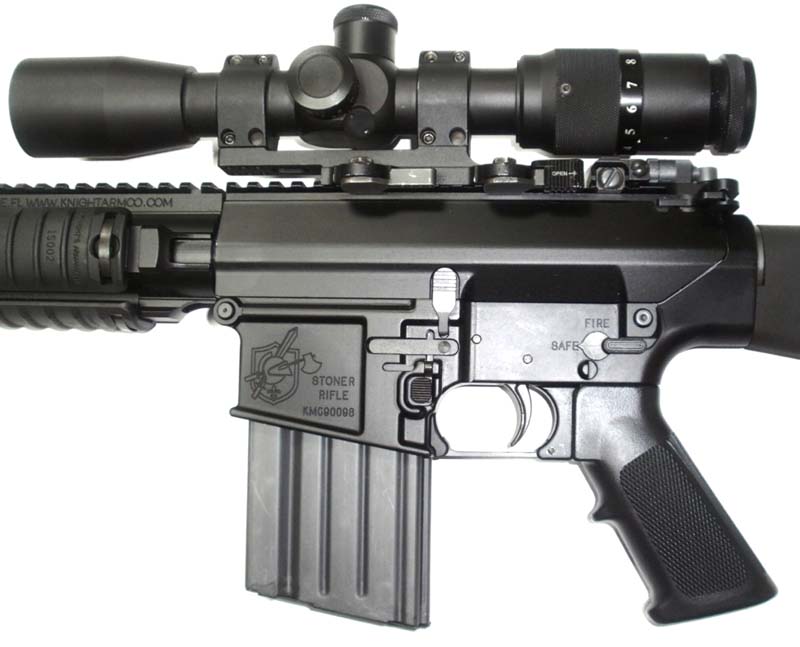


The Mk11 had some departures from the original design to meet the SOCCOM requirement. The rifle was designed to fire the M118 and M118LR match grade 7.62x51mm NATO ammunition and the Obermeyer barrel was shortened to 20 inches and equipped with a mount for a quick detachable sound suppressor also developed by Knight’s Armament Company. The 11.35 inch Rail Accessory System free floating handguard provided quad Mil-Std-1913 rails enabling attachment of any given number of accessories including night vision, lasers, tactical lights and bipods. The standard M16A2 stock and pistol grip are used for parts commonality. A flip up front sight was added to the gas block as well as KAC’s fully adjustable back up iron sight was also added. The rifle was equipped with 20-round magazines, a Leupold Vari-X mil dot scope with detachable rings and a Harris bipod. The Mk11 weighs 15.3 pounds unloaded and has an overall length of 45.4 inches long. The Mk11 would see action with U.S. Special Operations troops all over the world.
Knight’s Armament Company is first and foremost a defense contractor so commercial weapons were rare and due to the manufacturing process and quality they are very expensive. However, some did trickle down to the commercial market. In 2009, KAC introduced a new rifle, the SR-25 Enhanced Match Rifle. This rifle is a commercial version of the MK11 with the addition of the new URX free floating handguard that was designed for use on the M110 SASS (Semi Automatic Sniper System), which is replacing the M24 Remington sniper rifle in the U.S. Army.
The 20 inch barrel is the same as the one used on the Mk11. Through the evolution of the SR-25, the upper receiver was originally made from an aluminum extrusion; now the current rifles use forgings. The fired cartridge case deflector is now integral in the receiver rather than attached to the rail. Keeping with the tradition of the AR-10 and Gene Stoners expertise, no forward assist was added to the SR-25 family of weapons. The URX (Upper Receiver Extending) handguard as noted previously is a complete free floating handguard with a built-in folding front sight. When folded it acts as additional rail. The gas block has a section of rail on top of it as well as the mounting bracket for the QD sound suppressor. The rifle was supplied with three rail protectors enabling the rifle to be held and shot without a bipod. The upper receiver was also equipped with the KAC fully adjustable folding back up sight.
The bolt carrier group has gone through changes over the years. KAC has improved upon the chroming process and one of the finest features of the bolt carrier is the captive firing pin retainer pin. The carrier uses the standard M16 carrier key. The bolt has remained very similar to the original design with the major enhancement being to the extractor and ejector.
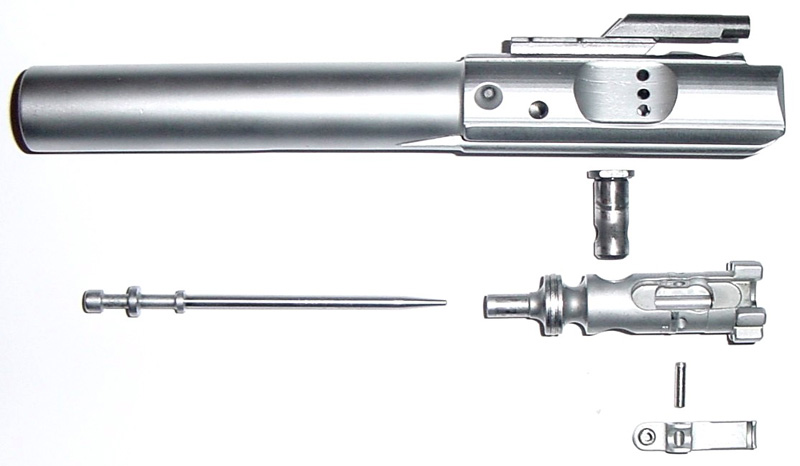
The lower receiver has most certainly gone through evolutionary changes. The area to the rear of the magazine release was machined down similar to the standard M16 making the button easier to actuate. The original SR-25 used a plastic spring guide, whereas the new rifle has an actual buffer. The standard M16A2 buttstock is used. Added to the left side of the receiver is an ambidextrous magazine release that can be reached by the trigger finger of a left-handed shooter. The trigger is the KAC designed two stage trigger which has an excellent crisp pull. The first stage is 3 pounds and the second breaks at around two pounds. The bolt catch has been redesigned from the original design. Originally it was a standard M16 bolt catch but with heavy use it proved not to be strong enough the take the weight and halt the 7.62mm bolt. KAC developed a stronger bolt catch.
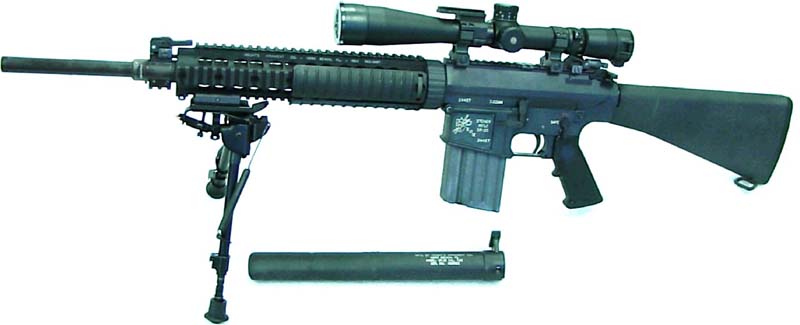
The SR-25 Enhanced Match Rifle weighs 10.4 pounds with an overall length of 39.5 inches. The barrel is 20 inches long. Using GI issue M118LR (175 grain) match ammunition produces a muzzle velocity of 2,560 feet per second. The rifle is supplied with a 20-round magazine and an operator’s manual as well as a safety lock.
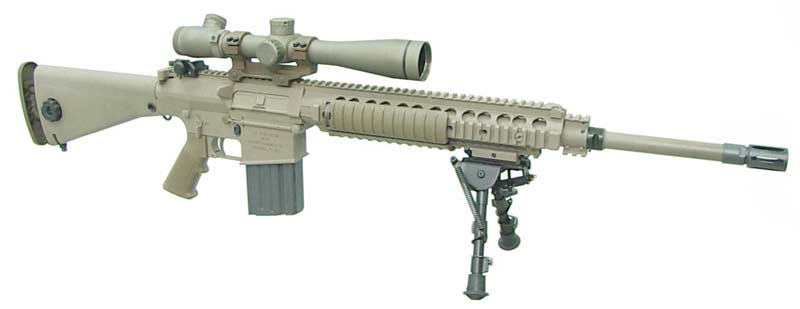
The test and evaluation rifle provided was just what I would have expected from Reed Knight. A precision rifle held to the highest craftsmanship and modern manufacturing standards. The rifle was not provided with an optic. Everybody has a different idea of what the best optic is and KAC lets that be up to the customer. Some additional magazines were procured and the rifle was tested with the new Magpul LMag and the C-Products 20-round steel magazines.
The ammunition used for testing was provided by Silver State Armory. Function testing was done with Silver State Armory M80 Ball (SSA10084-150FMJ). Accuracy testing was done with two different Silver State Armory loads. First was the 168 grain Sierra open tip match (SSA10084-OTM) and the second was the 175 grain Sierra open tip match (SSA10084-M118LR). The cartridge cases are manufactured by Silver State Armory to match specifications and their powder blends are proprietary and chosen for the particular load. Silver State Armory is known for their manufacturing of match quality ammunition in 5.56mm, 7.62mm, 6.8mm Rem SPC and a few others. They specialize in military calibers.
The barrel of the rifle was cleaned every 20 rounds with no malfunctions in 140 rounds that were fired. Targets were fired at 100 yards and both the 168 and 175 grain match rounds produced groups that averaged .45 to .75 inches – just as guaranteed by KAC and the target they provided. With the low round count I would expect the rifle to shoot even better if the barrel was broken in. The M110 will be with the U.S. military for quite some time.
| This article first appeared in Small Arms Review V14N1 (October 2010) |











